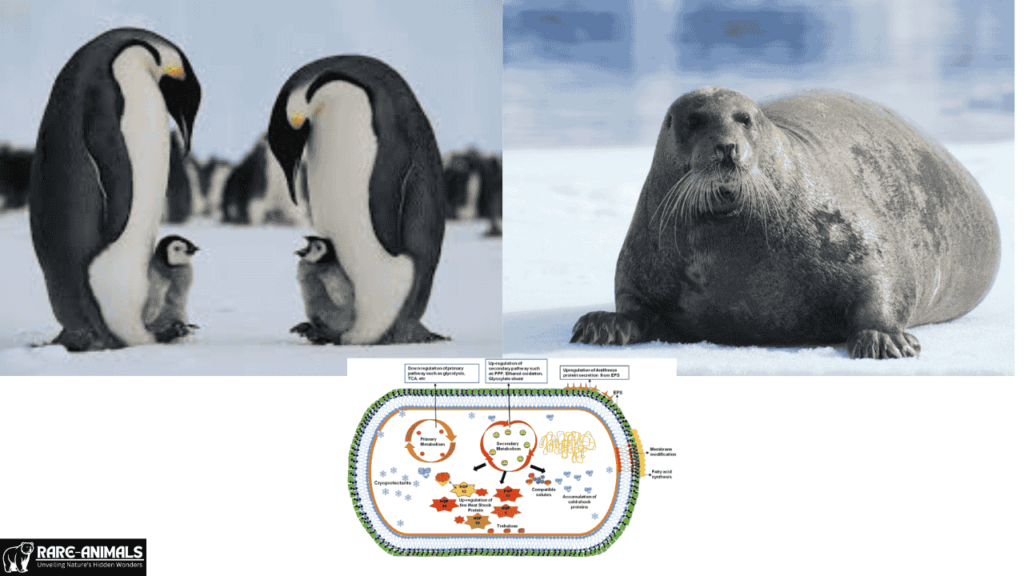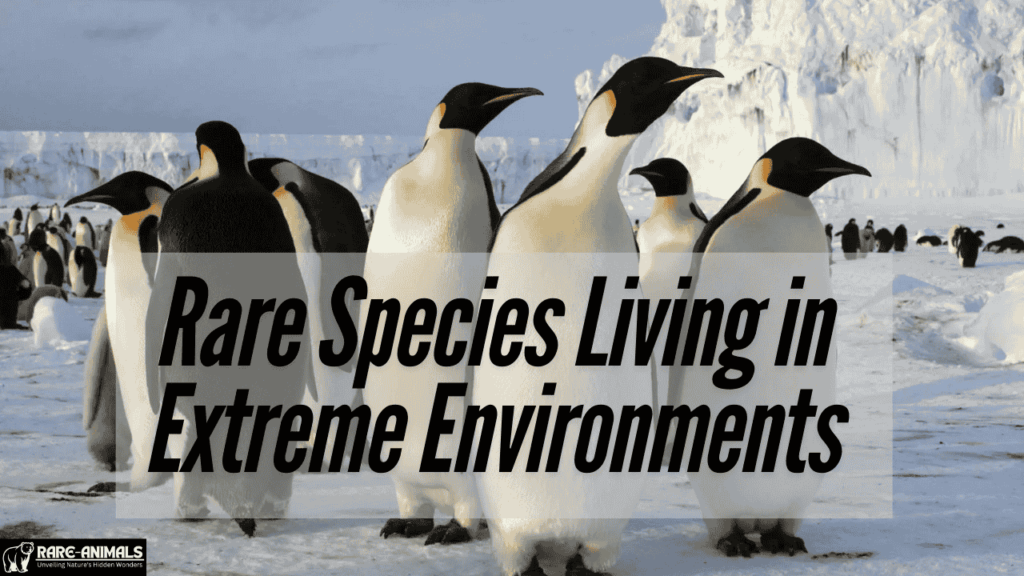The Earth is home to a remarkable variety of ecosystems, each with its own unique set of challenges for the organisms that inhabit them. While many species are adapted to live in relatively stable environments, there are others that thrive in extreme conditions—places that would be inhospitable to most life forms.
These extreme environments, which include scorching deserts, freezing polar regions, deep ocean vents, and highly acidic lakes, are populated by rare and resilient species with fascinating adaptations that allow them to survive and even flourish in the harshest of conditions.
In this article, we will explore some of the rarest species living in these extreme environments, examining how they have evolved to withstand such conditions and why studying them is crucial for understanding life on Earth.
From microscopic tardigrades to the towering emperor penguin, these organisms reveal the incredible potential for life to adapt and thrive in even the most inhospitable places.
What Are Extremophiles?
Extremophiles are organisms that live and thrive in extreme environments, where most life forms would not survive. These environments can include places with extreme temperatures, pressure, acidity, salinity, or radiation. Extremophiles have evolved unique physiological adaptations, enabling them to function in conditions that would be lethal to most species.
Some common types of extremophiles include:
- Thermophiles: Organisms that thrive at high temperatures, often found in hot springs, deep-sea hydrothermal vents, or near volcanic activity.
- Psychrophiles: Organisms that live in extremely cold environments, such as the polar regions or the deep ocean.
- Acidophiles: Species that thrive in highly acidic conditions, such as sulfuric lakes or volcanic environments.
- Halophiles: These organisms live in highly saline environments like salt flats, salt mines, or brine pools.
- Radiophiles: Organisms that can withstand extreme levels of radiation, found in places like nuclear reactors or outer space.

Understanding extremophiles is not only a matter of biological curiosity; these organisms hold key insights into the resilience of life and could even inform the search for life on other planets.
Extreme Environments and Their Inhabitants
Deep Sea Hydrothermal Vents
The deep sea, particularly around hydrothermal vents, is one of the most extreme environments on Earth. These vents are located on the ocean floor, often near tectonic plate boundaries, where volcanic activity releases heat and chemicals into the surrounding waters. The environment is characterized by extreme pressure, cold temperatures, and total darkness.
In these conditions, certain species have evolved to harness the heat and chemicals for survival. Instead of relying on sunlight for energy, as most organisms do, these organisms depend on chemosynthesis, a process that uses chemicals like hydrogen sulfide to create energy.
Notable Species:
- Tubeworms (Riftia pachyptila): These large worms live in the hot, mineral-rich waters around hydrothermal vents. They have a special relationship with chemosynthetic bacteria that help them survive by converting sulfur compounds into energy.
- Giant Clams (Calyptogena magnifica): These clams also harbor symbiotic bacteria in their tissues, which perform chemosynthesis to provide energy.
- Chemosynthetic Bacteria: These bacteria are the foundation of the food chain at hydrothermal vents, using chemicals like hydrogen sulfide to produce organic compounds that sustain other vent organisms.
| Species Name | Adaptation | Habitat |
|---|---|---|
| Riftia pachyptila | Symbiotic relationship with chemosynthetic bacteria | Hydrothermal vents in deep sea |
| Calyptogena magnifica | Symbiosis with chemosynthetic bacteria | Deep-sea hydrothermal vents |
| Chemosynthetic Bacteria | Use hydrogen sulfide for energy production | Deep-sea hydrothermal vents |
Hot Springs
Hot springs, typically found in volcanic regions, are another extreme environment. These locations have high temperatures, low oxygen levels, and sometimes acidic or alkaline conditions. Despite these harsh conditions, certain species have adapted to thrive in such environments.
Notable Species:
- Thermus aquaticus: A thermophilic bacterium, Thermus aquaticus thrives at temperatures up to 80°C. It is famous for providing the enzyme Taq polymerase, which is used in the polymerase chain reaction (PCR) technique, revolutionizing molecular biology.
- Other Thermophiles: Various types of thermophilic bacteria and archaea live in these environments, many of which are essential to the ecosystems of hot springs and geothermal features.
| Species Name | Adaptation | Habitat |
|---|---|---|
| Thermus aquaticus | Can withstand high temperatures, provides Taq polymerase | Hot springs and geothermal pools |
| Various Thermophiles | Survive in extremely hot and acidic conditions | Volcanic hot springs and geysers |
The Antarctic and Arctic Regions
The polar regions—both the Arctic and Antarctic—are among the coldest, most desolate places on Earth. Temperatures in these regions can drop below -30°C, and during the long polar nights, darkness can last for months. Despite these extreme conditions, life abounds in the frozen world of the poles.
Notable Species:
- Emperor Penguins (Aptenodytes forsteri): The largest of all penguins, emperor penguins thrive in the extreme cold of the Antarctic. They are well-adapted with thick layers of blubber and feathers to insulate against the cold. Their remarkable behavior includes huddling together in large groups to conserve heat during the winter months.
- Arctic Seals (e.g., Bearded Seal): Seals in the Arctic have thick layers of fat and fur to survive the cold waters. They are excellent swimmers, often diving to great depths to hunt for food.
- Cold-Adapted Microbes: In the icy waters of both the Arctic and Antarctic, microbes have evolved to function at temperatures that would freeze most other life forms. These microbes can survive under extreme pressure and low temperatures, contributing to the health of the polar ecosystems.

| Species Name | Adaptation | Habitat |
|---|---|---|
| Emperor Penguin | Thick blubber and feathers for insulation | Antarctic ice and coastal regions |
| Bearded Seal | Insulated fat layers, excellent diving ability | Arctic ice-covered waters |
| Cold-Adapted Microbes | Ability to survive in freezing temperatures | Arctic and Antarctic waters |
Deserts
Deserts are among the hottest and driest environments on Earth. They have extreme temperature fluctuations, from scorching daytime heat to freezing nights. Despite the harsh conditions, desert ecosystems are teeming with life, although most organisms here have specialized adaptations to conserve water and withstand temperature extremes.
Notable Species:
- Camels (Camelus dromedarius): Known as the “ships of the desert,” camels are well-adapted to desert life. They can go for long periods without water, thanks to their ability to store fat in their humps, which is metabolized into water when needed.
- Desert Rodents: Species like the jerboa or kangaroo rat are highly adapted to living without much water. They can survive on the moisture in the seeds they eat and have specialized kidneys to conserve water.
- Cacti: These plants store water in their thick, fleshy stems and have spines instead of leaves to reduce water loss.
| Species Name | Adaptation | Habitat |
|---|---|---|
| Camel | Fat storage in humps, water conservation mechanisms | Desert regions |
| Jerboa, Kangaroo Rat | Water conservation, nocturnal lifestyle | Desert regions |
| Cacti | Water-storing stems, spines to reduce water loss | Desert regions |
Acidic Environments
Some of the most hostile environments on Earth are those with extremely low pH, such as volcanic lakes and acidic hot springs. These environments are inhospitable to most organisms, but certain bacteria and archaea have evolved to not only survive but thrive in these acidic conditions.

Notable Species:
- Acidophilic Bacteria: These microorganisms thrive in acidic environments like the volcanic lakes of Mount Erebus or the Rio Tinto river in Spain, which is rich in sulfuric acid. These bacteria have specialized enzymes and cell membranes that protect them from acidity.
- Ferroplasma: A genus of archaea, Ferroplasma can live in environments with a pH as low as 0, such as sulfur-rich hot springs and acid mines.
| Species Name | Adaptation | Habitat |
|---|---|---|
| Acidophilic Bacteria | Specialized enzymes and membranes to resist acidity | Volcanic lakes, acidic hot springs |
| Ferroplasma | Survives in highly acidic conditions | Acid mines, hot springs |
Conclusion
Rare species living in extreme environments demonstrate the resilience and adaptability of life on Earth. From the microscopic extremophiles that thrive in the deepest parts of the ocean to the majestic emperor penguins that endure the frigid cold of Antarctica, these organisms have evolved unique survival strategies to cope with some of the most inhospitable conditions imaginable.
Studying these rare species is not only fascinating from a biological perspective but also essential for understanding the potential for life in extreme environments on other planets. These organisms provide valuable insights into the limits of life and offer clues about the conditions under which life might exist elsewhere in the universe.
FAQs
Q1: What are extremophiles?
A: Extremophiles are organisms that thrive in extreme environmental conditions, such as extreme heat, cold, pressure, acidity, or salinity, that would be inhospitable to most forms of life.
Q2: How do extremophiles survive in harsh conditions?
A: Extremophiles have evolved specialized adaptations, such as unique proteins, enzymes, and cell structures, that help them withstand extreme conditions. For example, thermophiles have heat-stable enzymes, and psychrophiles have antifreeze proteins that protect their cells in freezing temperatures.
Q3: Are there extremophiles that can survive in space?
A: Yes, some extremophiles, such as certain bacteria and tardigrades, are capable of surviving in space. They can endure extreme radiation, vacuum, and temperature fluctuations.
Q4: How do camels survive in the desert?
A: Camels are well-adapted to desert life, with thick skin to reduce water loss, the ability to store fat in their humps (which can be converted into water), and specialized nostrils that retain moisture.
Q5: Why are extremophiles important to science?
A: Extremophiles help us understand the limits of life, potentially informing the search for life beyond Earth. They also have practical applications, such as providing enzymes for industrial processes or medical treatments.

Alveena is an experienced content writer with a knack for crafting engaging and insightful pieces. She thrives on breaking down complex ideas and presenting them as clear, captivating content that resonates with readers.








30 thoughts on “Rare Species Living in Extreme Environments”